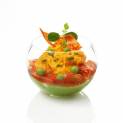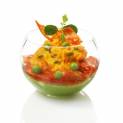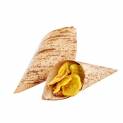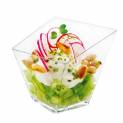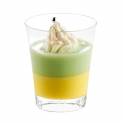
Bamboo Disposable Plates vs. Traditional Plates: Which is Better ?
In today's environmentally conscious world, choosing the right products for daily use is crucial for reducing our ecological footprint. One such decision is between bamboo disposable plates and traditional plates. Each type of plate has its advantages and disadvantages, but which one is truly better for the environment? Let's explore both options to help you make an informed decision.
Understanding Bamboo Disposable Plates
Bamboo disposable plates are made from bamboo, a fast-growing, renewable resource. These plates are designed to be used once and then discarded, often marketed as biodegradable and compostable.
Benefits of Bamboo Disposable Plates
-
Renewable Resource: Bamboo grows rapidly, making it a highly sustainable resource. It can grow up to 35 inches per day and reaches maturity within 3 to 5 years, much faster than traditional hardwoods.
-
Biodegradable: Bamboo plates are biodegradable and compostable. Under the right conditions, they break down within 3 to 6 months, unlike plastic plates that can take hundreds of years to decompose.
-
Low Environmental Impact: The production process for bamboo plates generally requires fewer chemicals and less energy than traditional plastic plates. This results in a lower carbon footprint.
-
Chemical-Free: Many bamboo disposable plates are made without harmful chemicals or toxins, making them safer for both the environment and human health.
-
Aesthetic Appeal: Bamboo plates have a natural, elegant look that can enhance the presentation of food, making them popular for events and gatherings.
Understanding Traditional Plates
Traditional plates include options made from various materials such as ceramic, glass, metal, and plastic. These plates are designed for multiple uses, often lasting for many years. Here are the benefits of traditional plates.
Benefits of Traditional Plates
-
Durability: Traditional plates are designed for long-term use. With proper care, they can last for decades, reducing the need for frequent replacements.
-
Reduced Waste: Because they are reusable, traditional plates contribute significantly less to landfill waste compared to single-use plates.
-
Variety of Materials: Traditional plates come in a variety of materials, each with its own environmental impact. For example, ceramic and glass plates are inert and do not release toxins into the environment.
-
Cost-Effective: Over time, traditional plates can be more cost-effective than disposable plates due to their longevity.
-
Versatility: Traditional plates are versatile in design and function, suitable for everyday use and special occasions.
Comparing Environmental Impacts
To determine which option is better for the environment, we need to compare the overall environmental impacts of bamboo disposable plates and traditional plates. Here are some key factors to consider:
Resource Sustainability
-
Bamboo Disposable Plates: Bamboo is a rapidly renewable resource, making it a highly sustainable option. The cultivation of bamboo also requires fewer pesticides and fertilizers compared to other crops.
-
Traditional Plates: The sustainability of traditional plates depends on the material. For example, glass and ceramic are made from abundant natural resources, but the energy required to produce them can be significant.
Waste Generation
-
Bamboo Disposable Plates: These plates generate waste after a single use, but they decompose relatively quickly under the right conditions.
-
Traditional Plates: Traditional plates generate minimal waste over their lifetime, as they are reused multiple times. However, when they do break, they may not be recyclable, depending on the material.
Energy Consumption
-
Bamboo Disposable Plates: The production process for bamboo plates generally consumes less energy compared to traditional plastic disposable plates. However, transportation energy can be a factor if they are imported.
-
Traditional Plates: The energy consumption for producing traditional plates is high, especially for ceramic and glass. Additionally, the energy used for washing these plates must be considered.
Making the Right Choice
When deciding between bamboo disposable plates and traditional plates, it's essential to consider the specific context of use.
-
Large Gatherings and Events: For large events where washing a large number of plates is impractical, bamboo disposable plates can be an eco-friendly choice, especially if they are composted after use.
-
Everyday Home Use: For daily use at home, traditional plates are generally better for the environment due to their reusability and durability.
-
Commercial Settings: Restaurants and cafes can benefit from using traditional plates to minimize waste and long-term costs. However, investing in energy-efficient dishwashers can help reduce the environmental impact of washing plates.
-
Outdoor Activities: For picnics, camping, and other outdoor activities, bamboo disposable plates offer a convenient and eco-friendly option, as they are lightweight and biodegradable.
Tips for Eco-Friendly Plate Usage
Regardless of your choice between bamboo disposable plates and traditional plates, here are some tips to further reduce your environmental impact:
-
Compost Bamboo Plates: If you choose bamboo disposable plates, ensure they are composted properly to maximize their environmental benefits.
-
Invest in Quality: For traditional plates, invest in high-quality, durable options that will last longer and reduce the need for replacements.
-
Energy-Efficient Dishwashing: Use energy-efficient dishwashers and eco-friendly detergents to minimize the environmental impact of washing traditional plates.
-
Local Products: Whenever possible, choose plates produced locally to reduce the carbon footprint associated with transportation.
-
Minimalist Approach: Adopt a minimalist approach to dining ware, using only what you need and avoiding unnecessary purchases.
Conclusion
At Sweet Flavor, the decision between bamboo disposable plates and traditional plates hinges on several factors, including their environmental impact, intended use, and personal preferences. Bamboo disposable plates are a sustainable choice, ideal for single-use scenarios due to their biodegradability. On the other hand, traditional plates offer a reusable option for everyday use, emphasizing longevity.
Ultimately, the most environmentally friendly choice prioritizes waste reduction, resource conservation, and sustainability. Whether you choose bamboo disposable plates or traditional ones, adopting mindful consumption habits and selecting eco-friendly options will help foster a healthier planet for generations to come.

